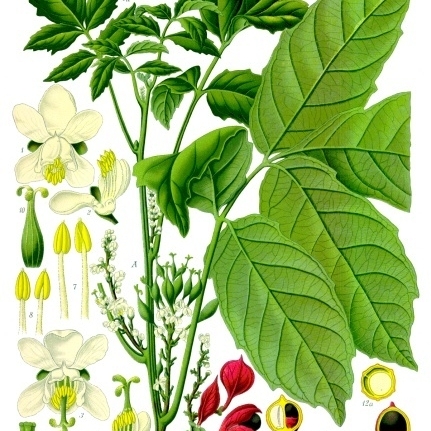Lianas, vines or less often understory shrubs; cross section with a single or multiple vascular cylinders, often producing milky sap. Stipules minute to foliaceous, persistent or deciduous. Leaves alternate, trifoliolate, pinnately 5-7(11)--foliolate, biternate, triternate, or partially bipinnate. Thyrses solitary or fascicled, axillary, distal, or cauliflorous, racemiform, spicate, or paniculate, with flowers in lateral cincinni or drepania. Flowers zygomorphic; calyx 4-5-merous, the sepals distinct, or the two anterior ones connate to different degrees into a larger sepal; petals 4, distinct, clawed, bearing a hood-shaped appendage, these with a fleshy, yellowish apex, smaller in lateral petals; disc unilateral, 2-or 4-lobed; stamens 8, the filaments of unequal length, usually pubescent; ovary 3-carpellate, the carpels with a single ovule. Fruit a septifragal (marginicidal) capsule, smooth, winged, rugose, or echinate, membranous, crustose, leathery or woody. Seeds usually globose, with a sarcotesta at base, but sometimes covering almost the whole seed.
Monoecious slender woody climbers, often with coiled tendrils at the base of the inflorescence. Leaves often stipulate, petiolate, variously compound, the petiole and rhachis commonly winged. Inflorescence an axillary (or cauliflorous in America) thyrse, simple, branched or clustered. Flowers slightly zygomorphic; sepals 5; petals 4 with scale prominent; disk reduced to little more than a unilateral pair of glands outside the stamens. Stamens and staminodes 8; anthers glabrous; filaments pilose, connate at the base. Ovary 3-locular with 1 ovule per locule; style trifid. Fruit a 3-valved obovoid capsule, often winged (not in Africa), sometimes spiny, dehiscing into 3 valves. Seeds borne on the central axis, black, arillate.
Woody climbers usually with paired spirally coiled tendrils arising at the apex of the peduncle; stems cable-like appearing to be composed of several coalescent axes (see t. 102 fig. 3).
Stamens 8, excentric, reduced or absent in the female flowers; filaments shortly connate at the base.
Ovary 3-locular, loculi 1-ovulate; style 3-fid; pistillode very reduced in the male flowers.
Petals 4, unequal, each with a large cucullate scale with an apical appendage.
Fruit capsular, 3-gonous or 3-winged; loculi 1-seeded; dehiscence septicidal.
Sepals 5, unequal, the 2 inner ones connate at the base.
Leaves stipulate, imparipinnate; leaflets 2-jugate.
Inflorescence a paniculate or racemoid thyrse.
Flowers spuriously polygamous, zygomorphic.
Disk unilateral, with 4 glands.
Seed with a fleshy arillode.

